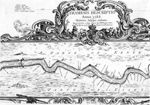
|
Robert Adams's Map of the River Thames, 1588 Why did the 'army' chose to place itself here in Essex? How decisive was this military gathering? Was the fate of the Armada directly linked to other glorious passages of English arms? Who exactly was at Tilbury? That the army was encamped at Tilbury has much to do with geography. It was reasonable to expect Spanish forces, once landed, to make their way to London, the capital and seat of Parliament as well as home to about 200,000 persons among no more than two or three millions for the whole country. The earliest crossing of the River Thames, which was negotiable by the English levies was at Tilbury. So that, were the enemy to land in Kent and not in the eastern counties, the army could quickly interpose itself between London and the invaders. There is a little doubt that Queen Elizabeth's fine words were in fact redundant. She may never have had to risk the heat of battle herself, for on that very day, Tuesday, 9th August, 'the wind blew so strongly' that the Armada was threatened by destruction on the banks of Zeeland. On the next day, Wednesday 10th August, a fresh south-westerly wind drove the Armada northwards. The planned Spanish link-up with the Duke of Parma and 18,000 land forces embarking from the Dunkirk area did not take place. There was nothing for the Armada to do but to 'obey the wind' and try to sail back to Spain by the 'North Sea', the Norwegian Channel and the Scottish Islands. Imminent dangers or not from Spanish land forces, there was always a risk in presenting the person of a ruler to crowds of subjects, especially armed ones. The tension in this event is captured well by a classic of historical writing, Garrett Mattingley's The Defeat of the Spanish Armada,(1959),pp.294-5:
It may be that jaundiced views are still colouring the history of these early modern times. One witness of modern class-rooms has spoken of the dangers of one-sided history and the exaggerated triumph of one sort over another. Perhaps there is too much of an English and Protestant victory over foreigners and Roman Catholics in our treatment of the Armada. In Essex it needs to be remembered that goodly numbers of the local levies were led by John Petre, J.P. whose private religious views are unknown, but who was married to a Roman Catholic. Whatever his private inclinations John Petre was fully prepared to serve. Folk worried then as now about heterogeneity of religious opinions and their supposed impact on loyalty, ['cuius eius relgio reliquo' was to be the phrase of the next century for that dangerous simplistic view which requires subjects to be of a similar persuasion to their ruler]. It was not to be until late Stuart times that an uneasy compromise was reached whereby it could be affirmed by a Sir Henry Vane that the magistrates's proper dominion was only over the body of a subject. Queen Elizabeth herself stated that she 'would make no windows into their souls'. The Adams's map has detail which intrigues the modern reader. Why is Kent which is to the south shown at the top of the map where North is usually depicted in modern maps? The conventions have to be learned before they become accepted. What is the nature of the lines criss-crossing the River Thames? Fields of fire may be postulated. Why is what looks like a bridge shown with a gap in the middle? This boom made of boats lashed together was a common device of the wars of the Low Countries of these years. Such a boom was erected on the Scheldt near Antwerp. Created to act as a barrier, yet with a gap to permit the free passage of shipping whilst the enemy's approach was not imminent.
|
||||||
 |
